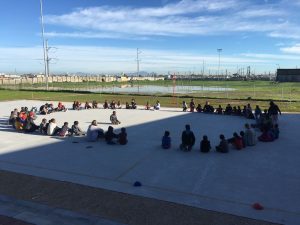
It was not until about our third day on project that the language barrier became a problem. If it had come up before then, I had not noticed; it was not yet relevant enough to affect my interactions. The “project” I am referring to is the holiday sports camp we run at the primary school in a township called Nomzamo. We were told (as it was advertised to the kids) that the camp was for 5th – 7th graders. In Nomzamo, the native language is Xhosa (pronounced ko-sah for us Americans who cannot seem to produce the clicking sounds properly).
“We improvised, we used questions and actions – both grand and silly – we used objects, other people, and lots of trial and error. For the most part, it was a two-way street in terms of effort – it was a partnership.”
The kids grow up speaking Xhosa but have English lessons in their schooling. However, when they reach 4th grade, suddenly all of their education switches to being in English. I cannot imagine having to do well enough in my Italian class to then finish out the rest of my college courses taught solely in that language. So, this knowledge of English already comes as an incredible feat. Since that switch happens in 4th grade, and we work with 5th – 7th graders, the language gap should not have been much of an issue. But, as always, things change.
The field we play on is open to all the kids of the township. Naturally, when the younger kids see the older kids playing with us, they want to join in as well, and we would not tell them no. We amass nearly 60 – 70 kids each day, reaching as young as 3 years old. Unsurprisingly, English comes as a challenge to these younger kids, if they even know any at all. Nonetheless, we want to include everyone in all that we do – which includes skills drills, sports games, and health lessons in the classroom. Explaining the rules, describing the drills, and teaching the lessons started becoming increasingly difficult as the days went on and we started collecting more and more kids into our program.

And yet, I still would not call it a language barrier, but rather a language hurdle. It was something that required work to jump over, but not a total road block. We improvised, we used questions and actions – both grand and silly – we used objects, other people, and lots of trial and error. For the most part, it was a two-way street in terms of effort – it was a partnership.
The kids continually asked me questions in Xhosa until they could understand; I would do my best to show them the desired action through acting out examples; my favorite of them all was when the older kids would intervene and play translator for everyone’s benefit. Most days, I would end the day sitting with a handful of kids in a circle trying my hand at speaking Xhosa. This was an activity that children of all ages loved to jump in during because they did not have to speak English to be able to correct my Xhosa. It gave them a chance to be the teacher, a sort of switching of roles. Though I am proud of the decent amount of Xhosa I have learned, I am far from any true speaking ability. But the effort exerted on both sides of the hurdle is what made all the difference.
